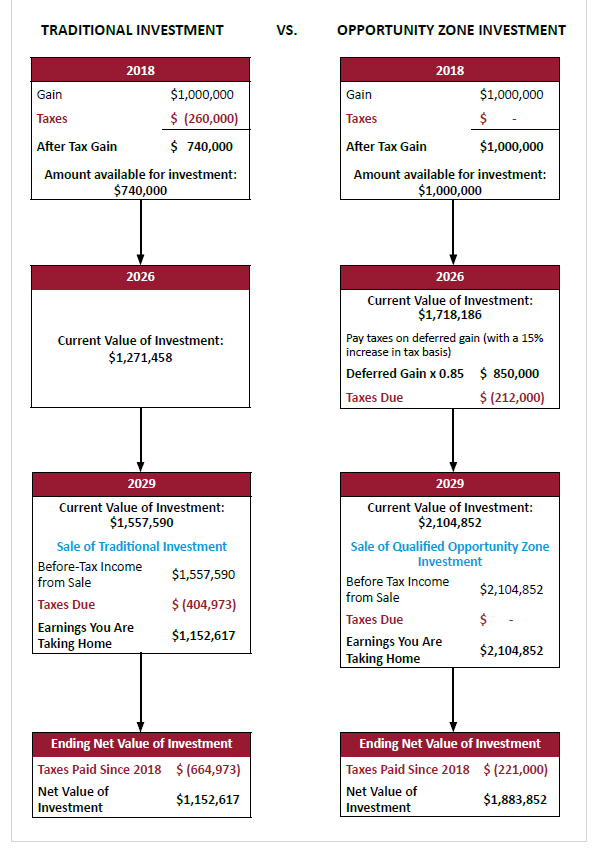All About Opportunity Zones
A valuable breakdown of the benefits
Garrett Parsons, Lee & Associates Inc. - NSDC
WHAT IS THE OPPORTUNITY ZONE PROGRAM?
The Opportunity Zone program is a tax incentive program that was brought to the
public through the Tax Cuts and Jobs Act of 2017 with the goal of bringing long term
investment capital into low-income areas to stimulate local economies and rehabilitate
distressed cities. Through the program, governors of the 50 states and 4 territories
were tasked with nominating zones with low incomes, high poverty rates, and high
unemployment rates to be approved and designated as Qualified Opportunity Zones by
the US Department of Treasury.
WHAT ARE THE OPPORTUNITY ZONES COMPRISED OF?
A total of 42,176 census tracts were eligible for Opportunity Zone Designation. Of
these 42,176 census tracts, 8,762 were designated as Qualified Opportunity Zones. The
average Opportunity Zone has a median household income of $33,345, a poverty rate
of 31.75%, and an unemployment rate of 13.41% (the current national unemployment
rate is 3.8%). There are about 31.3 million people in designated Opportunity Zones
across the United States, 56% of which are people of color. Out of the 8,762 designated
Opportunity Zones, 294 possess Native American lands.
TAX BENEFITS OF OPPORTUNITY ZONES
In an effort to encourage capital investment into these impoverished communities, the
Opportunity Zone program offers 3 main tax incentives:
(1) Tax Deferral: The first benefit is the deferral of tax on capital gains that are reinvested
into a Qualified Opportunity Zone Fund. The deferred gain is recognized
on December 31, 2026 or at the disposal of the Opportunity Zone investment,
whichever occurs first.
(2) Reduction of Tax Liability: The second benefit is a step-up in tax basis for capital
gains re-invested into an Opportunity Zone Fund. If the investment is held for
5 years or more, the tax basis of the investment is increased by 10%. If the
investment is held in the Opportunity Zone Fund for 7 years or more, the tax
basis is increased by 15%.
(3) Tax Exclusion: The third and greatest benefit is a permanent exclusion from any
tax on the appreciation of the Opportunity Zone investment if the investment is
held for at least 10 years.
WHAT ARE SOME OF THE REQUIREMENTS TO RECEIVE THE TAX BENEFITS OFFERED BY
THE OPPORTUNITY ZONE PROGRAM?
1. The tax benefits will only apply to the re-investment of any gain recognized from
2018 through 2026 by an individual or entity with no more than 20% overlapping
ownership of the subject property or business.
2. The subject property must have been acquired after December 31, 2017.
3. You must acquire interest in the Opportunity Zone Fund within 180 days after the
gain is recognized. If the property is sold for a note and a gain is reported on the
installment method than the 180 day clock starts running on the receipt of each
payment of the note.
4. The Qualified Opportunity Zone property must be substantially improved by
100% of the buildings value within a 30 month period.
5. After the first six-month period of a Qualified Opportunity Zone Fund’s tax year,
the fund must hold at least 90 percent of its assets in Qualified Opportunity Zone
property.


TALKING TO THE EXPERTS
When asked what to look for when searching for a good Opportunity Zone investment
property, Lee & Associates Opportunity Zone Specialist Garrett Sholer said, “When we
are looking for viable Opportunity Zone investments for our clients, the first and most
important thing we look for is property that can be re-developed; at minimum, it needs
to support a substantial increase in the rentable square footage. If an Opportunity
Zone investor is contemplating making improvements to an existing structure, potential
rents must be raised by a dramatic amount in order for the project to have any chance
of making sense under the Opportunity Zone requirements. The Opportunity Zone
investor must improve the property by 100% of the “Improvement Value” at purchase
under the guidelines.
Therefore, these improvements must dramatically improve the
desirability of the building and its income potential. As a “rule of thumb” we tell our
clients those capital improvements must raise the income potential by an order of
magnitude in the 50%+ range in order to justify the cost of the average project. Afterall,
the primary reason for participating in the Opportunity Zone program is creating tax
free federal capital gains. There is absolutely no point in making improvements that are
not likely to result in significant capital gains. Additionally, given today’s commercial
real estate climate in California, our Opportunity Zone team has observed that certain
types of redevelopment projects are attracting the lion’s share of attention; sites which
support hotels and various forms of multi-residential (i.e. apartments, senior housing,
assisted living and affordable housing), have received most the focus thus far. The
program certainly can be used for the redevelopment of industrial, retail, and mixed-use
sites, but it is much more difficult to transform those properties enough to justify
the efforts.”
Sources: IRS.gov, urban.org, taxpolicycenter.org, opzones.ca.gov
